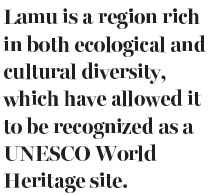Project brings opportunities and dangers

Port will provide a welcome lifeline and promises prosperity, but there could also be a downside
Lamu county is located in Kenya's Coast province, whose land area is 6,273 square kilometers. The county covers a strip of northeastern coastal mainland and the Lamu Archipelago, which consists of numerous islands extending about 100 km south from the Somalia border.
The best-known of the islands is Lamu, the oldest and best-preserved Swahili settlement in East Africa. But according to our observation, neighboring islands also have numerous archaeological remnants dating as far back as the 14th century.
Lamu is a region rich in both ecological and cultural diversity, which have allowed it to be recognized as a UNESCO World Heritage site. It is not only endowed with biodiversity on land but has some of the richest marine ecology on the Kenyan coastline. The county has two national reserves: Dodor; and Kiunga Marine. Covering 877 sq km, Dodori is a breeding ground for the East Lamu topi - a type of antelope - and is home to a variety of mammal and bird life, including lions, elephants, shrews, hippos, pelicans and more.

The 21st century has witnessed development of this old, quiet and pristine area. Kenya, South Sudan and Ethiopia have begun to construct a new $23 billion project that includes a port, a railway line and an oil refinery. According to reports, the port is expected to act as the main gateway to Africa's Great Lakes region, which includes the Horn of Africa, eastern Africa and central Africa. The initial investment will be provided by the three governments, with the project expected to be completed within four years.
This mega development will definitely transform the whole Lamu area, just as China was transformed in the 1990s. At that time, China experienced rapid modernization, urbanization and industrialization. The port project will change the landscape of Lamu and have a fundamental cultural and environmental impact, not only negative but also positive. As former Kenyan president Mwai Kibaki said, the project will provide the landlocked countries of the region with a direct and dependable route to the sea and help connect the entire eastern and central African region to international markets. It will bring new prosperity, new business and new technology.
However, cultural and environmental risks obviously exist. Lamu is a living, but endangered, heritage recognized by UNESCO. Locals are worried about the arrival of immigrant workers and fear unemployment. They also fear that the new port will have an adverse impact on the fragile ecosystems within the nearby marine reserve and the historical archaeological sites that are scattered throughout the islands of the archipelago.
UNESCO has spoken up and requested an impact assessment for the Lamu Town World Heritage site. This needs to be considered by the Kenyan government, the Kenyan Ports Authority and foreign donors. The Resettlement Action Plan needs to be completed and local participation in the project is also needed to balance the force of capital and politics.
The author is a professor in the Department of Anthropology at Sun Yat-sen University. The views do not necessarily reflect those of China Daily.
(China Daily Africa Weekly 09/15/2017 page8)
Today's Top News
- Ukraine crisis a lesson for the West
- Autonomous networks driving the progress of telecom sector
- China launches cargo drone able to haul up to 1.2 tons
- Key role of Sino-German ties stressed
- Tariffs hurt global trade: Experts
- Rescuers race against time to find survivors






























